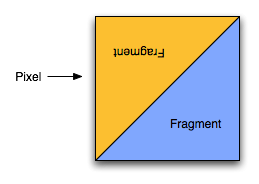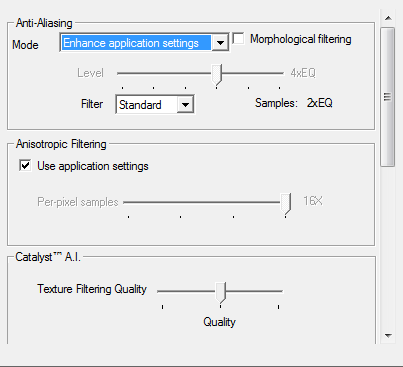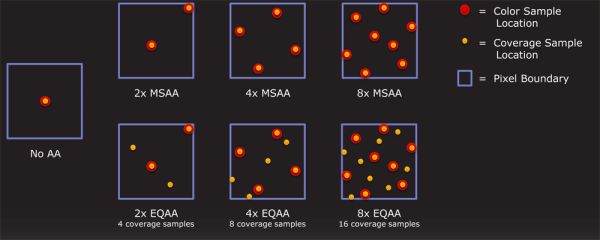AMD's Radeon HD 6970 & Radeon HD 6950: Paving The Future For AMD
by Ryan Smith on December 15, 2010 12:01 AM ESTAnother New Anti-Aliasing Mode: Enhanced Quality AA
With the 6800 series AMD introduced Morphological Anti-Aliasing (MLAA), a low-complexity post-processing anti-aliasing filter. As a post-processing filter it worked with a wide variety of games and APIs, and in most cases the performance overhead was not very severe. However it’s not the only new anti-aliasing mode that AMD has been working on.
New with the 6900 series is a mode AMD is calling Enhanced Quality Anti-Aliasing. If you recall NVIDIA’s Coverage Sample Anti-Aliasing (CSAA) introduced with the GeForce 8800GTX, then all of this should sound quite familiar – in fact it’s basically the same thing.
Under traditional MSAA, for a pixel covered by 2 or more triangles/fragments, 2, 4, or 8 subpixel samples are taken to determine what the final pixel should be. In the process the color of the triangle and the Z/depth of the triangle are both sampled and stored, and at the end of the process the results are blended together to determine the final pixel value. This process works well for resolving aliasing along polygon edges at a fraction of the cost of true super sampling, but it’s still expensive. Collecting and storing the Z and color values requires extra memory to store the values and extra memory bandwidth to work with the values. Ultimately while we need enough samples to determine colors of the involved triangles, we do not always need a great deal of them. With a few color/Z samples we have all of the color data we need in most cases, however the “hard” part of anti-aliasing becomes what the proper blending of color values should be.

1 Pixel Covred by 2 Triangles/Fragments
Thus we have EQAA, a compromise on the idea. Color/Z samples are expensive, but just checking if a triangle covers part of a subpixel is very cheap. If we have enough color/Z samples to get the necessary color information, then just doing additional simple subpixel coverage checks would allow us better determine what percentage of a pixel is covered by a given polygon, which we can then use to blend colors in a more accurate fashion. For example with 4x MSAA we can only determine if a pixel is 0/25/50/75/100 percent covered by a triangle, but with 4x EQAA where we take 4 color samples and then 4 additional coverage-only samples, we can determine blending values down to 0/12/25/37/50/62/75/87/100 percent coverage, the same amount of accuracy as using 8x MSAA. Thus in the right situation we can have quality similar to 8x MSAA for only a little over 4x MSAA’s cost.
In reality of course this doesn’t always work out as well. The best case scenario is that the additional coverage samples are almost as good as having additional color/Z samples, while the worst case scenario is that additional coverage samples are practically worthless. This depends on a game-by-game, if not pixel-by-pixel basis. In practice additional coverage samples are a way to slightly improve MSAA quality for a very, very low cost.
While NVIDIA has had the ability to take separate coverage samples since G80, AMD has not had this ability until now. With the 6900 hardware their ROPs finally gain this ability.
Beyond that, AMD and NVIDIA’s implementations are nearly identical except for the naming convention. Both can take a number of coverage samples independent of the color/Z samples based on the setting used; the only notable difference we’re aware of is that like AMD’s other AA modes, their EQAA mode can be programmed to use a custom sample pattern.
As is the case with NVIDIA’s CSAA, AMD’s EQAA mode is available to DirectX applications or can be forced through the drivers. DirectX applications can set it through the Multisample Quality attribute, which is usually abstracted to list the vendor’s name for the mode in a game’s UI. Otherwise it can be forced via the Catalyst Control Center, either by forcing an AA mode, or as is the case with NVIDIA, enhancing the AA mode by letting the game set the AA mode while the driver overrides the game and specifies different Multisample Quality attribute. Thus the “enhance application settings” AA mode is new to AMD with the 6900 series.

To be honest we’re a bit ruffled by the naming choice. True, NVIDIA did go and have to pick daft names for their CSAA modes (when is 8x not 8 sample MSAA?), but ultimately CSAA and EQAA are virtually identical. NVIDIA has a 4 year lead on AMD here, and we’d just as well use NVIDIA’s naming conventions for consistency. Instead we have the following.
| Coverage Sampling Modes: CSAA vs EQAA | ||||
| NVIDIA |
Mode (Color + Coverage) |
AMD | ||
| 2x | 2+0 | 2x | ||
| N/A | 2+2 | 2xEQ | ||
| 4x | 4+0 | 4x | ||
| 8x | 4+4 | 4xEQ | ||
| 16x | 4+12 | N/A | ||
| 8xQ | 8+0 | 8x | ||
| 16xQ | 8+8 | 8xEQ | ||
| 32x | 8+24 | N/A | ||
AMD ends up having 1 mode NVIDIA doesn’t, 2xEQ, which is 2x MSAA + 2x cover samples; meanwhile NVIDIA has 16x (4x MSAA + 12 cover samples) and 32x (8x MSAA + 24 cover samples). Finally, as we’ll see, just as is the case for NVIDIA additional coverage samples are equally cheap for AMD.











168 Comments
View All Comments
Ryan Smith - Wednesday, December 15, 2010 - link
Exactly the same as on Cypress.L2: 128KB per ROP block (so 512KB)
L1: 8KB per SIMD
LDS: 32KB per SIMD
GDS: 64KB
http://images.anandtech.com/doci/4061/MidLevelView...
I don't have the register file size readily available.
DanNeely - Wednesday, December 15, 2010 - link
How likely is the decrease from 2 to 1 operations per clock likely to affect real world applications?yeraldin37 - Wednesday, December 15, 2010 - link
My current cards are running at 870Mhz(GPU) and 1100Mhz(clock), faster than stock 5870, those benchmarks for new 6970 are really disappointing, I was seriously expecting to get a single 6970 for Christmas to replace my 5850OC CF cards and make room for additional cards or even have a free pcie to plug my gtx460 for physx capability. I was going to be happy to get at least 80% of my current 5850CF setup from new 6970. what a joke! I will not make any move and wait for upcoming next generation 28nm amd GPU's. We have to be fair and mention all great efforts from AMD team to bring new technology to newest radeon cards, however not enough performance for die hard gamers. If gtx 580 were 20% cheaper I might consider to buy one, I personally never ever pay more than $400 for one(1) video card.Nfarce - Wednesday, December 15, 2010 - link
Reading Tom's Hardware they essentially slam AMD's marketing these cards as a 570-580 beater. Guru3D is also less than friendly. Interstingly, *both* sites have benches showing the 570 an d580 beating the 6950 and 6970 commandingly. What's up with that exactly?fausto412 - Wednesday, December 15, 2010 - link
it's called AMD didn't deliver on the hype...they deserve to get slammed.medi01 - Wednesday, December 15, 2010 - link
AMD delivers cards with better performance/price ratio that also consume less power. How come there is a reason to "slam", eh?zst3250 - Friday, December 31, 2010 - link
Off yourself cretin, prefearbly by getting your cranium kicked in.Mr Perfect - Thursday, December 16, 2010 - link
Wait, is Tom's reputable again? Haven't read that site since the Athlon XP was new....AnnonymousCoward - Wednesday, December 15, 2010 - link
As a 30" owner and gamer, I would never run at 2560x1600 with AA enabled if that causes <60fps. I'd disable AA. Who wouldn't value framerate over AA? So when the fps is <60, please compare cards at 2560x1600 without AA, so that I'm able to apply the results to a purchase decision.SimpJee - Wednesday, December 15, 2010 - link
Greetings, also a 30'' gamer. If you see the FPS above 30 with AA enabled, you can assume it will be (much) higher without it enabled so what's the point in actually having the author bench it without AA? Plus, anything above 30 FPS is just icing on the cake as far as I'm concerned.